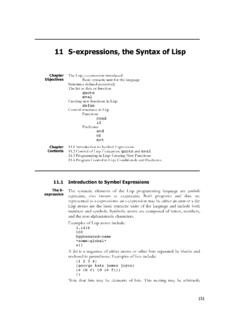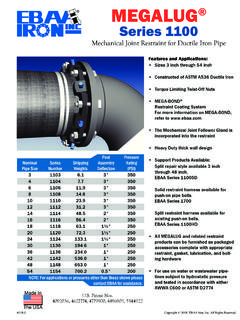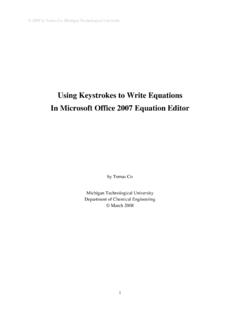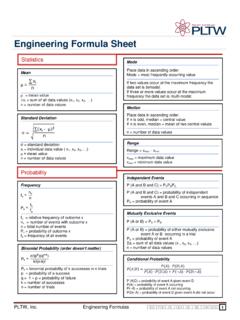Transcription of Dosimetric Calculations - University of New Mexico
1 Dosimetric Calculations Lonny Trestrail 20 October 2008. Objectives Dose Distribution Measurements PDD, OCR. TAR, SAR, TPR, TMR, SPR, SMR. Arc or Rotational Therapy Isodose Curves Point Dose Calculations Wedged Fields Photon Beam Models 2. Definition of Tumor Volumes 3. Definition of Terms SSD Source Skin Distance (F) . SAD Source Axis Distance (Fm) . 4. Definition of Terms CAX Central Axis Isocenter 5. Percentage Depth Dose %Dn = Dn / D0 x 100%. Varies w/Depth Beam Energy Depth Field Size Source Distance Collimation 10x10, dMax 6. %DD vs. Photon Beam Energy 7. %DD Tables 8. MDE Conventional PDD Tables 9. MDE Convolution PDD Tables 10. Sterling's Rule Effective Field Size This rule states that a rectangular field is equivalent to a square field if bot h have the same ratio of area/perimeter (A/P) . Example 15x8 has an A/P of has an A/P of ~ ( ) . 4 A/P = 11. Transverse Profile 12.
2 TAR Used in Calculating Arc Rotations Use average TAR, not average depth 13. TAR Measurement 14. Tissue Air Ratio (TAR). TAR = Dd / Dair Where: Dd: dose to a small volume of tissue in a medium Dair: dose to a small volume of tissue in air Depends on: Energy, Depth, Field Size Accounts for tissue attenuation Used for isocenter treatments and rotational treatments 15. Scatter-Air Ratio (SAR) . SAR = TAR(finite fs) TAR(zero fs) . Depends on: Energy, Depth, Field Size Useful in do s e computation of irregularly shaped fields 0x0 fs: hypothetical field rep 16. Irregularly Shaped Fields Clarkson's integration Separates primary and secondary Primary contribution Zero area TAR. Secondary contribution Sum of irregularly shaped scatter contribution 17. Clarkson's Irregular Field calculation 18. Tissue/Phantom Ratio (TPR) . TPR = Dd / Dref Where: Dd: dose to a point in phantom Dref: dose at the same point at a fixed ref depth Depends on: Energy, Depth, Field Size 19.
3 TPR Measurement If t0 is the ref depth of max dose, then: TMR(d, rd) = TPR(d, rd) . 20. Tissue Maximum Ratio (TMR) . TMR = Dd / DrefMax Where: Dd: dose to a point in phantom DrefMax: dose at the same point at maxRef depth Depends on: Energy, Depth, Field Size 21. Scatter/Phantom Ratio (SPR) . Ratio of the dose contribution solely by scattered radiation at a given point divided by the reference dose at a selected depth in the phantom 22. Scatter-Maximum Ratio (SMR) . Ratio of the dose caused solely by scattered radiation at a given point divided by the maximum dose measured at the same distance from the radiation source 23. Isodose Curves Lines passing thru points of equal dose Percentage of the dose at a reference point Dose distribution off axis CAX depth dose distribution is not sufficient to characterize a radiation beam that produces a dose distribution in a three- dimensional volume.
4 24. Isodose Curves SSD normalized at dMax SSD normalized at depth (isocenter) 25. Isodose Curves Perpendicular to CAX. 26. Point Dose Calculations Treatment unit calibration Calibrated at defined SSD (100 cm) . dMax, 5, 10 cm deep Calibrated at isocenter dMax, 5, 10 cm deep MU calculation depends upon calibration Meter Setting (MU) =. Prescribed dose related to calibration conditions Calibration dose rate 27. Treatment at Standard SSD. MU = Given Dose / Dose Rate at dMax Given dose: (Rx'd dose @ depth)*100 / (%Dn) = Dose at dMax Dose rate at dMax: Dm = Dc Sc Sp F. Dc: calibrated dose rat e at dm for 10x10 cm field size, or (1 cGy/MU) . Sc: collimator s c atter factor normalized to 10x10 cm field size 28. Treatment at Isocenter Meter setting (MU) =. Prescribed dose at isocenter Dose rate at isocenter Meter setting (MU) =. Prescribed dose at isocenter Dc [(SSD+dMax)/SAD]2 TMR Sc Sp F.
5 29. Distribution of Multiple Fields Parallel opposed fields CAX. CAX depth dose opposed fields vs. energy Equal weighted or unequal weighted beams Minimum dose in mid-plane Build up at entrance of both fields Often normalized to 100% or dose to a point (tumor) in the patient 30. CAX Depth Dose vs. Energy 31. Parallel Opposed Beams 32. Example Problem A patient is to be treated using a AP/PA. pair of fields and a SSD technique. The patient is 22 cm thick. The field size is 10x15 cm with minimal blocking, however a block tray is used. The physician prescribes Gy at Gy/. treatment to the 90% isodose line. The fields are equally weighted at dMax from each field. How many MU's are needed/. day for each field? 33. Example Problem A patient is to be treated using a AP/PA. pair of fields and a SSD technique. The patient is 22 cm thick. The field size is 10x15 cm with minimal blocking, however a block tray is used.
6 The physician prescribes Gy at Gy/. treatment to the 90% isodose line. The fields are equally weighted at dMax from each field. How many MU's are needed/. day for each field? 34. Answer MU = Prescribed Dose / Field / Day %DD*100*TF*ROF. MU = 180 cGy / 2 / %DD(12x12 @ d11)*TF*ROF(12) . MU = 100. * * MU = 157 MU. 35. External Beam Plan 36. Answer MU = Prescribed Dose / Field / Day %DD*100*TF*ROF. MU = 180 cGy / / 2 / 1. %DD(12x12 @ d11)*TF*ROF(12) . MU = 100. * * MU = 156 MU. 37. MDE PDD 38. MDE Tray Factor 39. MDE Output Factor 40. Plan Summary 142 vs 156. Rx Isodose dMax Field Size Effective Square Fast Photon . 143 vs 156. Scatter . 41. The Wedged Beam Metal wedge shaped filter is put in beam to tilt isodose curve Angle usually defined at d10, or 50% isodose Types of wedge filters Solid metal Universal Dynamic wedge Isodose curves change with field size Flatness changes with depth 42.
7 Isodose Curve of Wedged Beam 43. Wedged vs. Unwedged Fields 44. 45. 46. Typical Head & Neck Plan 47. Photon Inhomogeneity Correction Density affects attenuation of x-rays Lung with a density of attenuates much less than normal tissue Bone with a higher density and atomic number attenuations x-rays more Inhomogeneities also affect scatter Lung corrections 10-15% for 5-8 cm lung tissue 48. Photon Beam Models Analytical method: %DD x OAR. Matrix Technique: Fan lines and %DD. Semi-Empirical Methods Clarkson Integration Differential Scatter Air Ratio Heterogeneity Corrections Co n v olution Superposition Algorithm (Kernels) 49.







